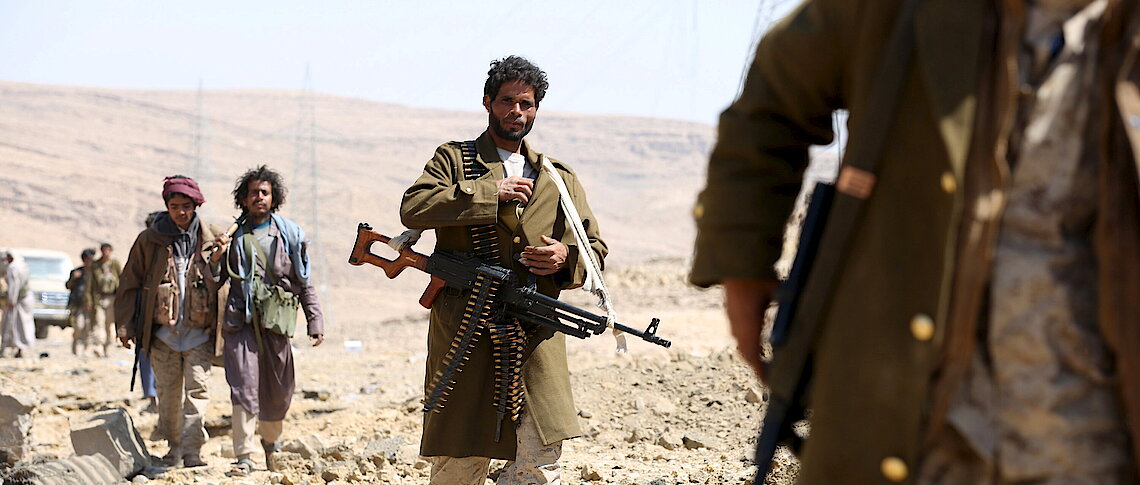Read this article in German.
The continuing wars and violent conflicts in the Near and Middle East are extremely complicated – and intricately interwoven. Despite the humanitarian catastrophe in the country, military campaigns in Yemen are being perpetrated unrelentingly. Saudi Arabia and Iran are the main adversaries here, both relying on their local partners as they struggle for supremacy in the region. But Egypt and other countries in the region are also involved in the conflict.
In Syria, meanwhile, the war is far from over, even though the IS has now more or less been defeated. And then there’s the deadly conflict between Israelis and Palestinians, smouldering for the last seven decades and always ready to flame up at a moment’s notice: current US policy in the region is now fanning the flames, hardening the resolve of the two parties rather than helping to find a peaceful solution.
In this highly militarised region, each and every government pursues an expansion of military capabilities.
It’s a complex state of affairs – and European involvement encompasses, first and foremost, the export of military hardware. In Germany, recent weeks have seen a heated debate about whether to extend or lift the current block on supplying arms to Saudi Arabia. After the US and China, the has the world’s highest defence spending and is the region’s biggest importer of weapons systems, buying in over USD 22bn worth of arms. Other large-scale weapons-importers in the region are the United Arab Emirates, Turkey, Iraq, Qatar, and Israel – all of which have been sold weapons by, among others, Germany. Submarines, launches, frigates, tanks, armoured vehicles, helicopters, rockets, guns.
In this highly militarised region, each and every government pursues an expansion of military capabilities: according to figures from the Stockholm International Peace Research Institute, seven of the ten countries with the highest levels of military spending (measured as a percentage of GDP) came from the Near and Middle East. While Germany is still debating whether it will be able to up its defence spending to 2 per cent of GDP in the coming years, Israel’s budget sees 4.7 per cent spend on the military, while Saudi Arabia and Oman splash out 10.3 per cent and 12.1 per cent respectively.
Why Europe should follow its own rules
More than half of all weapons imported into the region are sold by the US; the UK and France supply state-of-the-art systems to a dozen countries there, too, offering a broader range than Germany; Spain and Italy also export military hardware into the region.
In the debate in Germany with regard to arms exports to Saudi Arabia – all the more controversial because of its effect on joint projects carried out with the British and the French – it’s worth taking another look at the guidelines which have been in place up until now. Anyone following the debate could easily gain the impression that Germany’s government has become unpredictable in its armaments policy and, by extension, an unreliable partner going forward: yet in the EU Code of Conduct on Arms Exports (1998) and the EU Common Position (2008), member states agreed to set and adhere to ‘high common standards’ which should be regarded as ‘the minimum’.
Specifically, this includes a provision to refuse export licences if there’s a clear risk and that weapons sold ‘might be used for internal repression’. This raises the question of whether this provision has, in the case of exports to the Near and Middle East, ever been taken seriously at all. Further, there’s mentioning of the special importance of ‘the respect of human rights in the country of final destination’ – a criteria which, if ever applied, would have blocked any form of arms export to Saudi Arabia in the first place.
The EU criteria also stipulate that ‘the existence or likelihood of armed conflict between the recipient and another country’, which would be another reason to deny exports.
What’s more, the legal situation in Germany is quite clear. An armaments control law stipulates that government must reuse permission to export military hardware if there’s any danger that it may be used to disrupt peace or go against the obligations of humanitarian principles. As such, German arms exports to Saudi Arabia have not become problematic with the murder of Saudi journalist Jamal Kashoggi, but rather should have been stopped long ago in compliance with the EU guidelines and German laws.
The EU criteria also stipulate that ‘the existence or likelihood of armed conflict between the recipient and another country’, which would be another reason to deny exports. There’s no shortage of reports by the United Nations and a range of civil society organisations that clearly document the way those involved in the Yemen war are contravening basic human rights. So the question should not be why Germany suddenly stopped exports, but rather why it allowed them for so long. And how the United Kingdom and France are getting away with raising their finger and moralising at Germany for being unreliable, when really, there should be an outcry that EU countries are shamelessly supplying this war-torn region with weapons. What is the point of an EU Code of Conduct on Arms Exports when it’s so flagrantly ignored?
Back in 2008, the EU member states agreed on ‘convergence’ in their arms exports. When, in Germany’s domestic debate, some pretend that it’s the Germans who must moderate their restrictive position to take account of the more permissive policies of other member states, it’s all too quickly forgotten that many other European countries are in fact not exporting arms to the coalition behind the Yemen conflict: the Netherlands, Flanders as a region, and Sweden, for instance. It’s also ignored that the carefree arms-exporters are flouting the EU guidelines they helped to shape. As such, any calls to ‘adapt the guidelines’ are tantamount to asking for export restrictions to be abolished.






